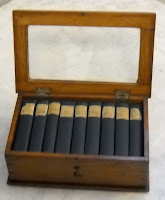 The famous last word and repeating refrain from Edgar Allan Poe's classic poem The Raven is arguably a one word summary of the entire work. First published in 1845, the poem follows an anonymous narrator as he mourns the "lost Lenore" and attempts to divine his own fate by questioning a mysterious raven whose only response is "Nevermore." The supernatural atmosphere and imagery evoked by the story and language of the poem have inspired many artists, including John Tenniel of Alice in Wonderland fame and Édouard Manet.
The famous last word and repeating refrain from Edgar Allan Poe's classic poem The Raven is arguably a one word summary of the entire work. First published in 1845, the poem follows an anonymous narrator as he mourns the "lost Lenore" and attempts to divine his own fate by questioning a mysterious raven whose only response is "Nevermore." The supernatural atmosphere and imagery evoked by the story and language of the poem have inspired many artists, including John Tenniel of Alice in Wonderland fame and Édouard Manet. One of the more famous illustrated editions of the poem was published in 1884 (New York: Harper & Brothers) and features works by Gustave Doré who completed the twenty-six illustrations only a short time before his own death in 1883. Doré's visual interpretation perfectly complements the gothic nature of the poem and certainly adds additional elements of the eerie and haunted to the experience.
 |
| "Doubting, dreaming dreams no mortal ever dared to dream before." |

